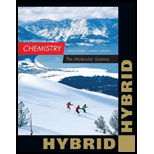
(a)
Interpretation:
Enthalpy of formation of Silver chloride has to be calculated by using Born-Haber cycle.
Concept Introduction:
Born-Haber cycle:
The enthalpy of formation of ionic crystals are calculated by addition of enthalpies of atomization, ionization, affinity and lattice enthalpy, it is given by Born-Haber so it is called as Born-Haber cycle.
(a)
Explanation of Solution
Enthalpy of formation of Silver chloride is calculated as,
Hence, the enthalpy of formation of Silver chloride is
(b)
Interpretation:
Enthalpy of formation of Sodium chloride has to be calculated by using Born-Haber cycle.
Concept Introduction:
Refer part (a).
(b)
Explanation of Solution
Enthalpy of formation of Silver chloride is calculated as,
Hence, the enthalpy of formation of Silver chloride is
(c)
Interpretation:
The common factor for the differences in
Concept Introduction:
Refer part (a).
(c)
Explanation of Solution
In the ionization and sublimation endothermic process of both compounds are,
From the given vales,
Want to see more full solutions like this?
Chapter 5 Solutions
Chemistry: The Molecular Science, Hybrid Edition (with OWLv2 24-Months Printed Access Card)
- The reaction of quicklime, CaO, with water produces slaked lime, Ca(OH)2, which is widely used in the construction industry to make mortar and plaster. The reaction of quicklime and water is highly exothermic: CaO(s)+H2O(l)Ca(OH)2(s)H=350kJmol1 (a) What is the enthalpy of reaction per gram of quicklime that reacts?. (b) How much heat, in kilojoules, is associated with the production of 1 ton of slaked lime?arrow_forwardWhen boron hydrides burn in air, the reactions are very exothermic (a) Write a balanced equation for the combustion of B5H9(g) in air to give B2O3(s) and H2O(g). (b) Calculate the enthalpy of combustion for B5H9(g) (fH = 73.2 kJ/mol), and compare it with the enthalpy of combustion of B2H6 (2038 kJ/mol). (The enthalpy of formation of B2O3(s) is 1271.9 kJ/mol.) (c) Compare the enthalpy of combustion of C2H6(g) with that of B2H6(g). Which transfers more energy as heat per gram?arrow_forwardGiven the following data calculate H for the reaction On the basis of the enthalpy change, is this a useful reaction for the synthesis of ammonia?arrow_forward
- Hydrogen, H2, is prepared by steam reforming, in which hydrocarbons are reacted with steam. For CH4, CH4(g)+H2O(g)CO(g)+3H2(g) Calculate the enthalpy change H for this reaction, using standard enthalpies of formation.arrow_forwardConsider the reactions of silver metal, Ag(s), with each of the halogens: fluorine, F2(g), chlorine, Cl2(g), and bromine, Br2(l). What chapter data could you use to decide which reaction is most exothermic? Which reaction is that?arrow_forwardThe first step in the preparation of lead from its ore (galena, PbS) consists of roasting the ore. PbS(s)+32O2(g)SO2(g)+PbO(s) Calculate the standard enthalpy change for this reaction, using enthalpies of formation (see Appendix C).arrow_forward
- Use a Born-Haber cycle (Sec. 5-13) to calculate the lattice energy of MgF2 using these thermodynamic data. Compare this lattice energy with that of SrF2, −2496 kJ/mol. Explain the difference in the values in structural terms.arrow_forwardOf the five elements Sn, Si, Sb, O, Te, which has the most endothermic reaction? (E represents an atom.) What name is given to the energy for the reaction? E(g)E+(g)+earrow_forwardAt large interatomic separations, an alkali halide moleculeMX has a lower energy as two neutral atoms, M + X; atshort separations, the ionic form (M+)(X-) has a lowerenergy. At a certain distance, Rc, the energies of the twoforms become equal, and it is near this distance that theelectron will jump from the metal to the halogen atom during a collision. Because the forces between neutral atomsare weak at large distances, a reasonably good approximation can be made by ignoring any variation in potentialV(R) for the neutral atoms between Rc and R - `. For theions in this distance range, V(R) is dominated by theirCoulomb attraction.(a) Express Rc for the first ionization energy of the metalM and the electron affinity of the halogen X.(b) Calculate Rc for LiF, KBr, and NaCl using data fromAppendix F.arrow_forward
 Chemistry & Chemical ReactivityChemistryISBN:9781133949640Author:John C. Kotz, Paul M. Treichel, John Townsend, David TreichelPublisher:Cengage Learning
Chemistry & Chemical ReactivityChemistryISBN:9781133949640Author:John C. Kotz, Paul M. Treichel, John Townsend, David TreichelPublisher:Cengage Learning Chemistry & Chemical ReactivityChemistryISBN:9781337399074Author:John C. Kotz, Paul M. Treichel, John Townsend, David TreichelPublisher:Cengage Learning
Chemistry & Chemical ReactivityChemistryISBN:9781337399074Author:John C. Kotz, Paul M. Treichel, John Townsend, David TreichelPublisher:Cengage Learning Chemistry by OpenStax (2015-05-04)ChemistryISBN:9781938168390Author:Klaus Theopold, Richard H Langley, Paul Flowers, William R. Robinson, Mark BlaserPublisher:OpenStax
Chemistry by OpenStax (2015-05-04)ChemistryISBN:9781938168390Author:Klaus Theopold, Richard H Langley, Paul Flowers, William R. Robinson, Mark BlaserPublisher:OpenStax General Chemistry - Standalone book (MindTap Cour...ChemistryISBN:9781305580343Author:Steven D. Gammon, Ebbing, Darrell Ebbing, Steven D., Darrell; Gammon, Darrell Ebbing; Steven D. Gammon, Darrell D.; Gammon, Ebbing; Steven D. Gammon; DarrellPublisher:Cengage Learning
General Chemistry - Standalone book (MindTap Cour...ChemistryISBN:9781305580343Author:Steven D. Gammon, Ebbing, Darrell Ebbing, Steven D., Darrell; Gammon, Darrell Ebbing; Steven D. Gammon, Darrell D.; Gammon, Ebbing; Steven D. Gammon; DarrellPublisher:Cengage Learning Chemistry: The Molecular ScienceChemistryISBN:9781285199047Author:John W. Moore, Conrad L. StanitskiPublisher:Cengage Learning
Chemistry: The Molecular ScienceChemistryISBN:9781285199047Author:John W. Moore, Conrad L. StanitskiPublisher:Cengage Learning Chemistry: Principles and PracticeChemistryISBN:9780534420123Author:Daniel L. Reger, Scott R. Goode, David W. Ball, Edward MercerPublisher:Cengage Learning
Chemistry: Principles and PracticeChemistryISBN:9780534420123Author:Daniel L. Reger, Scott R. Goode, David W. Ball, Edward MercerPublisher:Cengage Learning





